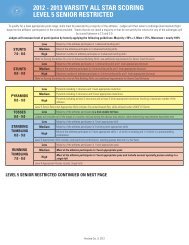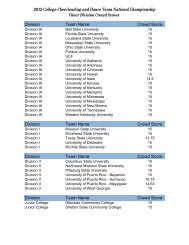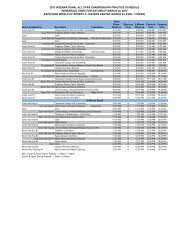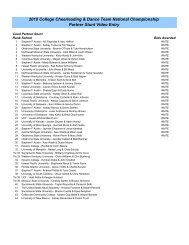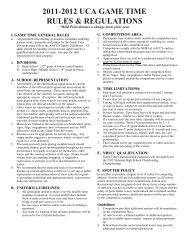2012-2013 UCA GAME TIME - Universal Cheerleaders Association ...
2012-2013 UCA GAME TIME - Universal Cheerleaders Association ...
2012-2013 UCA GAME TIME - Universal Cheerleaders Association ...
Create successful ePaper yourself
Turn your PDF publications into a flip-book with our unique Google optimized e-Paper software.
14. A top person may be moved from a vertical position to a<br />
face up or face down straight body horizontal position<br />
provided all the following conditions are met:<br />
a. The top person maintains contact with at least one<br />
original base or spotter.<br />
b. Two or more additional catchers/bases catch the upper<br />
body of the top person.<br />
c. When the catchers are not the original bases, the top<br />
person may not begin in or pass through an extended<br />
overhead position.<br />
d. The catchers remain close to the original bases and<br />
must be in place prior to the movement to the horizontal<br />
position.<br />
e. The base(s) do not turn.<br />
f. The base(s) has/have constant visual contact with the<br />
catchers.<br />
15. A single‐base may not be the only primary support for two<br />
extended top persons. The exception to this rule is the<br />
following:<br />
a. Double Cupies/Awesomes are allowed. If dismounted<br />
to cradles, there must be three people for each top<br />
person being cradled.<br />
16. Dismounts to the performing surface from shoulder<br />
height or above must have assisted landings.<br />
17. A swinging stunt is legal provided all the following<br />
conditions are met:<br />
a. A downward movement is only allowed from below<br />
shoulder height.<br />
b. The top person is face up.<br />
c. The top person begins from the performing surface<br />
or a stunt that is below shoulder height.<br />
18. Single‐based split catches are prohibited.<br />
19. Tension drops are prohibited<br />
D. Pyramids<br />
Note: In addition to these specific pyramid rules, all persons and<br />
stunts involved in a pyramid must follow all rules from the<br />
Partner Stunt and Inversion sections.<br />
1. The top person in a pyramid must receive primary support<br />
from a base or be connected to a bracer who is on a base. A<br />
bracer may not support a majority of a top person’s weight.<br />
2. In braced pyramids, at least one bracer of each pair must be<br />
at shoulder height or below. The exception to this rule is the<br />
following:<br />
a. Extensions (double‐ or single‐based) may brace other<br />
extensions.<br />
3. Partner stunts and pyramids may not pass over, under or<br />
through other partner stunts or pyramids.<br />
4. If a person in a pyramid is used as a brace for an extended<br />
stunt, that brace must not be supporting a majority of the top<br />
person's weight. (To demonstrate this, the foot of the top<br />
person’s braced leg must be at or above the knee of their<br />
supporting leg.)<br />
5. Hanging pyramids must have a continuous spotter for each<br />
shoulder stand involved in suspending another person.<br />
Hanging pyramids are not allowed to rotate.<br />
6. In a Released Pyramid Transition the following rules apply:<br />
a. The top person must have at least two bases. Exception:<br />
a single‐base tick tock is permitted provided the top<br />
person remains upright.<br />
b. The bases may make up to one quarter turn around the<br />
bracer.<br />
c. The top person and all bracers at shoulder level must<br />
have a spotter in place during the transition movement.<br />
(Shoulder sits and double‐based thigh stands do not<br />
require an additional spotter.)<br />
d. The top person must be in hand/arm to hand/arm<br />
contact with at least one bracer during the entire<br />
transition.<br />
e. The top person may not be supporting his or her weight<br />
on any other body part of the person(s) assisting (i.e.<br />
Shoulders of the bracer).<br />
f. The top person must be continuous in motion and<br />
cannot be supported so that they pause during the<br />
transition.<br />
For braced inversion pyramids, see E6.<br />
E. Inversions<br />
Note: Inversions are partner stunts or pyramids in which the top<br />
person has her or his shoulders below the waist. In addition to<br />
the following rules, all persons involved in an inversion must<br />
follow all rules from the Partner Stunt and Pyramid sections.<br />
1. Unless allowed under the rules in this section, a top person<br />
must not be in an inverted position.<br />
2. Forward suspended rolls are permitted provided:<br />
a. The top person begins from the performing surface or<br />
from a stunt shoulder height or below.<br />
b. The top person maintains continuous hand‐to‐hand<br />
contact with two bases or two posts who control the top<br />
person’s dismount to the performing surface or cradle.<br />
3. Backward suspended rolls are permitted only from the<br />
performing surface provided the top person maintains<br />
continuous hand‐to‐hand/arm contact with two posts<br />
who control the top person back to the performing<br />
surface.<br />
4. A top person may be moved from a weight‐bearing, inverted<br />
position on the performing surface to a noninverted position<br />
at any height provided both the following conditions are<br />
met:<br />
a. At least one base or spotter protects the<br />
head/neck/shoulder area of the top person.<br />
b. This base or spotter must maintain contact with the top<br />
person until he/she is no longer inverted.<br />
5. A top person may be inverted in partner stunts in which<br />
the base of support remains below shoulder level<br />
provided both the following conditions are met:<br />
a. At least one base or spotter protects the<br />
head/neck/shoulder area of the top person. This base<br />
or spotter must maintain contact with the top person<br />
until he/she is no longer inverted.<br />
b. During a downward inversion, two original bases or<br />
one original base and a spotter maintain contact<br />
with the top person in a position to protect his/her<br />
head, neck and shoulder area. This contact must be<br />
maintained until the top person’s hands are on the<br />
performing surface or he/she is no longer inverted.<br />
6. A braced forward or backward flip in a pyramid is<br />
allowed provided all of the following conditions are met:<br />
a. The top person maintains continuous<br />
hand‐to‐hand/arm contact with a separate bracer on<br />
each side.<br />
b. The bracers must be in double based shoulder<br />
stands or elevator preps (no single base, shoulder sit<br />
or thigh stand bracers).<br />
c. Each bracer has a separate spotter.<br />
d. The bases remain stationary except as necessary for<br />
safety adjustments.



